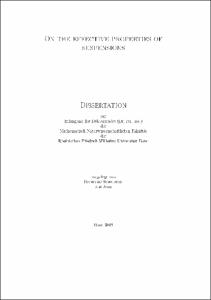On the effective properties of suspensions

On the effective properties of suspensions

| dc.contributor.advisor | Niethammer, Barbara | |
| dc.contributor.author | Schubert, Richard | |
| dc.date.accessioned | 2020-04-26T09:39:41Z | |
| dc.date.available | 2020-04-26T09:39:41Z | |
| dc.date.issued | 04.02.2019 | |
| dc.identifier.uri | https://hdl.handle.net/20.500.11811/7853 | |
| dc.description.abstract | Einstein's formula for the viscosity of dilute suspensions describes how rigid particles immersed in a Stokes-fluid increase its macroscopic viscosity in terms of the particle volume density ∅. However, up to now, a rigorous justification has only been obtained for dissipation functionals of the flow feld. In this thesis, a cloud of N spherical rigid particles of radius R suspended in a fluid of viscosity μ is considered. It is rigorously shown that the homogenized fluid in the regime NR3 → 0 as N → ∞ has, in accordance with Einstein's formula, the viscosity μ' = μ ( 1 + 5/2∅) to first order in ∅. This is done by establishing L∞ and Lpp estimates for the difference of the solution to the microscopic problem and the solution to the homogenized equation. Regarding the distribution of the particles, it is assumed that the particles are contained in some bounded region and are well separated in the sense that the minimal distance is comparable to the average one. The main tools for the proof are a dipole approximation of the flow feld of the suspension together with the so-called method of reflections and a coarse graining of the volume density. By a very close mathematical analogy to electrostatics a similar result, regarding Maxwell's formula for the conductivity of suspensions, is proven, namely that the conductivity of the homogenized material is η' = η (1 + 3∅) to first order in ∅. | en |
| dc.language.iso | eng | |
| dc.rights | In Copyright | |
| dc.rights.uri | http://rightsstatements.org/vocab/InC/1.0/ | |
| dc.subject.ddc | 510 Mathematik | |
| dc.title | On the effective properties of suspensions | |
| dc.type | Dissertation oder Habilitation | |
| dc.publisher.name | Universitäts- und Landesbibliothek Bonn | |
| dc.publisher.location | Bonn | |
| dc.rights.accessRights | openAccess | |
| dc.identifier.urn | https://nbn-resolving.org/urn:nbn:de:hbz:5n-53310 | |
| ulbbn.pubtype | Erstveröffentlichung | |
| ulbbnediss.affiliation.name | Rheinische Friedrich-Wilhelms-Universität Bonn | |
| ulbbnediss.affiliation.location | Bonn | |
| ulbbnediss.thesis.level | Dissertation | |
| ulbbnediss.dissID | 5331 | |
| ulbbnediss.date.accepted | 13.07.2018 | |
| ulbbnediss.institute | Mathematisch-Naturwissenschaftliche Fakultät : Fachgruppe Mathematik / Institut für angewandte Mathematik | |
| ulbbnediss.fakultaet | Mathematisch-Naturwissenschaftliche Fakultät | |
| dc.contributor.coReferee | Velázquez, Juan J. L. |
Files in this item
This item appears in the following Collection(s)
-
E-Dissertationen (4378)




